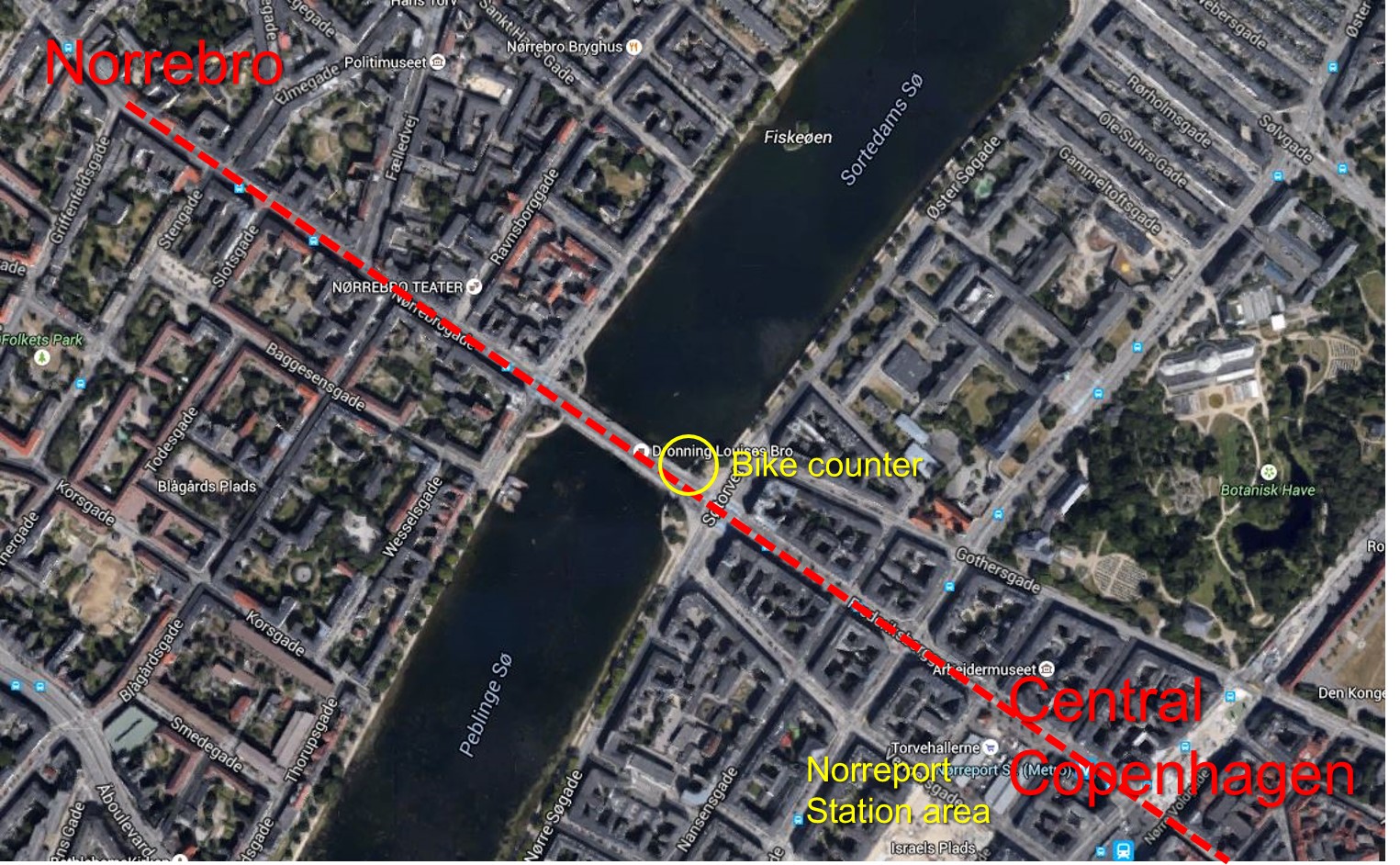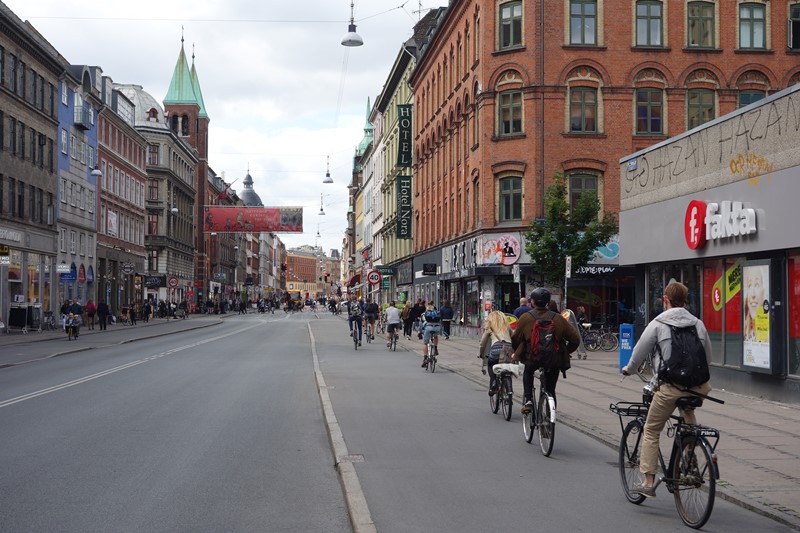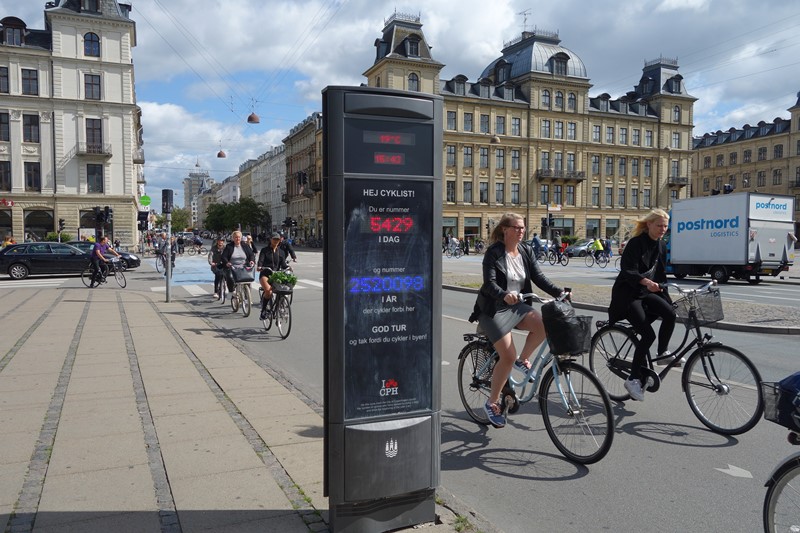I was curious to see the busiest cycle route in Copenhagen – Norrebrogade – said to be used by 36,000 cyclists a day, as described in A View from the Cycle Path: “Nørrebrogade is … 3 km long and taking a straight line path right through the city (map here). … it and the bridge on it are a funnel for cycle-traffic which uses this as one of the most direct routes to several locations.”
.
.
The Norrebro neighbourhood is rather analogous to, say, Grandview Woodland. Norrebrogade is its Commercial Drive.
.
.
Most of the right-of-way, after a lengthy public process, was rebuilt over the last half decade to remove car lanes for more dedicated space for bikes and transit.
Even today on Google Streetview you can see the difference on the bridge during reconstruction ….
.
And after …
.
The results in use are here.
.
I was particularly intrigued to see this:
The famous bike counter on Queen Louise Bridge.
.
If this bike counter looks like the one at the southwest corner of the Burrard Bridge, no coincidence. Andreas Roehl was the City of Copenhagen’s bike program manager at the time the project was being designed around 2010. Later, Andreas spent a year in Vancouver with Urban Systems, and served as a consultant to the City of Vancouver at the time we were designing our separated bike routes. The Copenhagen influence is apparent.
What astonished me, though, was not just the similarity of design, but the actual use of well-designed infrastructure in the city we look to as a world leader. Look carefully at the above shot: this picture was taken at 3 pm on Friday July 10, before the evening rush. The number of cyclists going one-way to Norrebro on this summer afternoon was …
5,429
.
Having posted pics of the counters on Burrard Bridge and at Science World on Price Tags, typically taken by Ken Ohrn, I was familiar with our volumes. But on return, I asked Ken to take a picture of the counter on Burrard, just to get the latest numbers. Here’s his shot from July 15, at 7:15 pm.
.
The number of cyclists recorded going both ways on Burrard Bridge was …
6,256
.
To repeat, this is the volume of two-way traffic on the Burrard Bridge. To get a more accurate comparison, double the number from Copenhagen, and then add on thousands more at rush hour. Obviously, the number of cyclists in Copenhagen is greater – which is exactly what you’d expect. This is Copenhagen!
But here’s the point: Vancouver is not that far from generating a cycling volume approaching that of one of the busiest routes in a city that is one of the most cycling-oriented in the world. Effectively, we’re already in the same league as Copenhagen, and progressing faster, in a city where critics are still claiming that the number of people cycling doesn’t and won’t justify the costs.
Norrebrogade was rebuilt to deal with existing demand; we’re still in the business of generating cycling traffic. But already, we’re not far off.
To those who think Vancouver could never be like Copenhagen, well, arguably we already are.



















What’s the 2520098 number?
It seems like the Danish bridge gets a bit more than three times as many bike trips as Burrard Bridge, based on the yearly totals.
Unfortunately, this metric ignores a lot of factors like the size of the city, the number of parallel bridges/other routes, etc.
BUT as a very rough indicator, it does suggest that Copenhagen’s numbers are within reach for Vancouver. (As indeed, they are for many cities.)
The big difference is that in Copenhagen, they provide direct obvious access to the bridge for people on bikes by building protected bike lanes on the main access road. In Vancouver, people on bikes are diverted to side roads like Hornby and Cypress as soon as possible.
This has proven to be rather ineffective as people on bikes also want to go to destinations on the main road, Burrard, and on the opposite side of the main road; the West End for example.
At least they are planning protected bike lanes north to Burnaby on Burrard but should have them to at least St Paul’s. Who is going to cross busy Burrard and Hornby twice and travel 200m out of their way to get to Hornby.
On the south side, water work is being planned from 1st to 16th but no plans yet to make Burrard more bike friendly.
Author
Number in the year so far. We should reach a million in August, thinks Ken Ohrn.
“At least they are planning protected bike lanes north to Burnaby on Burrard ”
Are we talking about the Burrard bridge and intersection upgrade? I didn’t know they were going to up that far? Can you send a link to the consultations for this? I want to let them know my views.
http://vancouver.ca/streets-transportation/burrard-bridge-and-pacific-street-intersection-upgrades.aspx
Thanks Ken, I didn’t know they were extending it that far. I emailed them saying they should extend the separated bike path to Comox. That would at least connect with existing/planned bike route rather than forcing someone to go south to Hornby and then back up again to go up to Comox.
Exactly.
Just so you know I emailed the COV yesterday morning and I got a response yesterday evening:
”
Hello
I see that in the current plan a separated path on Burrard Street is being extended North to about Burnaby street.
This should be extended to Helmcken to allow for a direct route to the existing bike route there near Comox. If it is AAA it should be a more direct route for anything going Northwest so they do not have to go south to Hornby bike route.
Thank you
Thank you for your interest in the Burrard Bridge and Pacific Intersection Improvements Project.
We’ve copied City Clerk’s office who will ensure that your comments get passed along to the Mayor and Councillors.
The proposal is to bring the protected bike lanes as far north as Burnaby St, where we could accommodate a local street connection to the rest of the West End (that could be improved in the future by adding a signal at Thurlow). We’ve looked at extending the protected bike lanes further north, but there are a lot of challenges north of Burnaby in terms of street width. With the Burnaby connection, cyclists would have the choice of using Burnaby or detouring to Hornby (using Drake) to access Comox/Helmcken.
”
1)Its good to email them, if more of us do that they are more likely to be more ambitious about the project
2)They are working hard they responded after 9pm so they must be getting a lot of responses before the vote.
3)The vote is soon, you can still submit an email!, if you are able to comment here you should have the time to send them a quick email.
The main difference is that in Copenhagen, bikes seem to be used as a mean of transportation (bike have fender, basket,… with normally dressed people on it).
in Vancouver, as the picture strikingly illustrates, it is still mainly used as a mean of exercising…
Let’s don’t lie to ourselves: If Vancouver is in the same league as Copenhaguen, then virtually all european cities are in this league
Another difference, is that in Copenhagen, cycling infrastrusture are not built at the expense of transit, but of single vehicle use.
Seriously Voony? Vancouver is a causual city. You have no idea what those people are doing.
And your comment regarding cycling at the expense of transit is really not correct. One bus stop was moved. It is a way over the top overreaction and rather divisive.
“in Vancouver, as the picture strikingly illustrates, it is still mainly used as a mean of exercising…”
Yes of course, everyone who exercises does so with a backpack… NOT.
At least we can all agree on the weakness of the experimental design? Too many confounding variables here to know for sure
The main reason people can dress so fancy in Copenhagen is that it is so flat — you don’t really have to sweat. It looks a lot denser too, so perhaps trips don’t have to be that far. It’s one thing to bike 1 km in a suite jacket to work, another to bike 10.
No one else really dresses “fancy” in Vancouver, not sure why people expect people on bikes would be really different.
Vancouver an a Copenhagen have similar densities.
Big difference is typically Vancouver bike routes are indirect and unobvious hidden on side streets where many people just don’t notice them. Only 1.5 out of 28 streets downtown have protected bike lanes meaning people have to either battle traffic all the way or go way out of their way battling traffic to get to one.
And there are huge gaps in other parts of the city to.
Talk about big gaps, what about Powell st east of clark, until Wall st. Bleh. After that nice bike path on the overpass, just nothing. No shoulder on powell either. People ride on the north sidewalk, but that is not great for anybody.
Yeah, Powell is a big gap that needs fixing ASAP. Funneling all the bike traffic in that part of the city down Adanac is not a good idea.
“Another difference, is that in Copenhagen, cycling infrastrusture are not built at the expense of transit, but of single vehicle use.”
You’re looking for enemies in all the wrong places.
Thank you Voony for pointing out a disbenefit that is often overlooked as the city works to improve active transportation infrastructure.
I still don’t see the disbenefit? How is public transit made worse off?
Vooney went in-depth here. In this case, the southbound bus stop at Burrard and Pacific, which had been previously relocated to the north, is now relocated again further North, significantly reducing the walkshed accesible to the Burrard buses. If this were an isolated case and the city pointed out that this was a disbenefit balanced against other benefits of the plan, it wouldn’t be such a problem. However, with this project, temporary and planned permanent closures of Robson, and proposed protected bike lanes on Commercial, transit is getting the short end of the stick without it being acknowledged. In comparison, every very loss of a parking space get’s its own sentence.
“Vooney [sic] went in-depth here.”
The headline from that link: “Burrard bridge: the war on Transit continues”
Bollocks. There is no war on transit in Vancouver. Desperate rhetoric for a weak argument. Furthermore, I challenge you to find a bicycling advocate who doesn’t also value public transit. Voony is trolling, and poorly at that.
“If this were an isolated case and the city pointed out that this was a disbenefit balanced against other benefits of the plan, it wouldn’t be such a problem.”
From the city’s report:
“Bus stop at Burrard-Pacific. During the engagement process, several residents and stakeholders commented that they would like to see a southbound bus stop on Burrard at Pacific. The stop could be accommodated but it would require removal of the large Cypress tree at the southwest corner of the Burrard-Pacific intersection, something which we would not support. The Cypress tree was likely planted shortly after the
opening of the bridge in 1932 and staff are focusing efforts on preserving the tree. The current design would instead accommodate a new bus stop in the curb lane on Burrard, south of Drake St (a half-block closer the [sic] Burrard-Pacific than it is now).”
(http://former.vancouver.ca/ctyclerk/cclerk/20150722/documents/ptec2.pdf)
“temporary and planned permanent closures of Robson”
Nothing to do with cycling.
“proposed protected bike lanes on Commercial”
A suggestion from the community that already considers buses. From the project’s web site:
“Our goal is to make Commercial Drive a street that works for everyone. The core changes we are aiming for include widened sidewalks, better transit and transit shelters, separated bike lanes, better pedestrian crossings and more marked or signalized crosswalks, more street furniture, and more landscaping.”
“Please note that these renderings are NOT our final recommendations and that we appreciate and consider all feedback on our proposed plan”
“Protruding bus stop increases speed of bus flow and leaves more space on the sidewalk for pedestrians”
(http://www.streetsforeveryone.org/commercial-drive/)
blockage, disadvantage, hindrance, obstruction. Please, any of these instead of disbenefit. Its unwordiness is hurting my brain.
Reblogged this on ManSlide and commented:
Experience Sweden online – http://www.sweden.se
I think this is incredibly encouraging. Especially with the recent defeat of the transit expansion, it can often get quite depressing to think about the future of active transportation in the region. However, that thinking ignores the broader arch of progress we’re experiencing. No matter how many people whinge and moan, more and more people are choosing active forms of transportation and that exerts a nascent pressure to provide better and more comprehensive service for them.
Thanks Fbfree.
Regarding the development on the Burrrad bridge Norh End, and the new proposed bus stop location, I have stated my opinion here https://voony.wordpress.com/2015/07/21/burrard-bridge-a-follow-up/
https://voony.files.wordpress.com/2015/07/burradpacificalt.jpg
@N “1) It’s good to email them….”
I agree. It is even better to provide input to the engineering or planning departments, as appropriate, earlier during the consultation phase as that way changes and suggestions can be incorporated in the design. By the time it goes to Council, it is essentially a finished package. But letting Council know that you support the improvements does help.
I found the City to be very responsive in terms of feedback on the proposals for this project. We had City engineers present to our volunteer group at HUB to better understand the background on this project. We provided feedback there, but we also submitted a formal response with some concerns. We were contacted by the City to see if we could meet again to review their responses to our concerns. There was a third meeting after that. All of this led to significant improvements in the design, including the ability for bikes to travel eastbound across Burrard. There were other points, but that was the most significant. The biggest gap we saw is the lack of connectivity westbound on Pacific between Seymour and Howe, in front of the on and off ramps. The connectivity on Burrard up to Burnaby was previously requested to the City during a consultation on Spot Improvements, as was the pinch point on Pacific westbound from Hornby. Both have been addressed in this project, so I think it is worth continuing to press for improvements.
I read elsewhere (on Voony’s blog) that changes “popped up” that were not shown at the open houses. Some of those were at least in part the result of our submissions, and the fact that they were incorporated is a positive, not a negative, IMO. If we are going to have public consultations, we shouldn’t be surprised if those consultations lead to changes. It is to be expected, and the City should be congratulated, to counter those who say that it is a done deal so not worth providing input.
I agree Jeff, I did provide input in the beginning but not for so much of an expansion. I did not expect COV to be so willing to expand the coverage area of the separated bike paths.
It is some very good scope creep, that we should all push for.